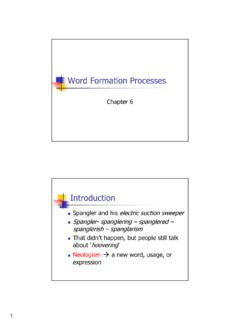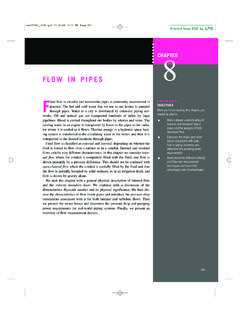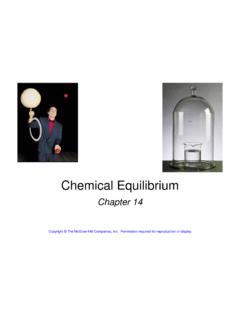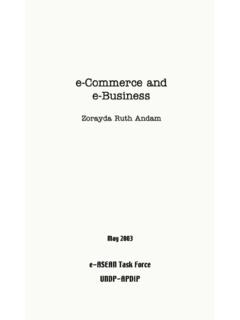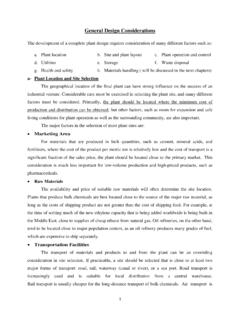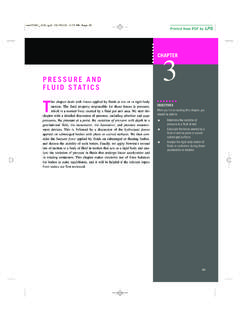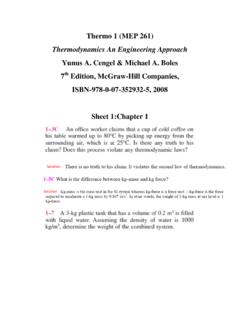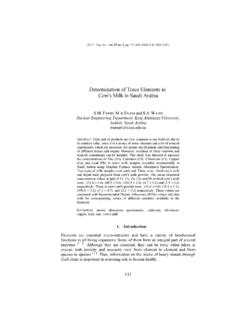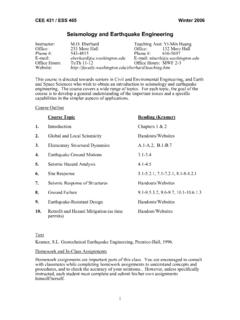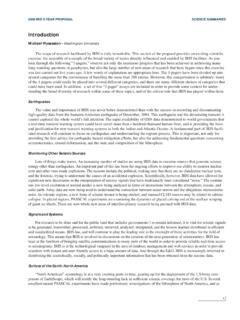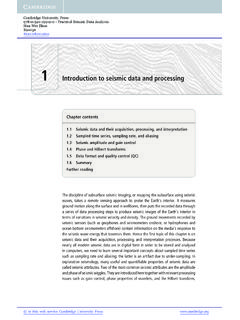Transcription of Stanford Mathematical Geophysics Summer School Lectures ...
1 Stanford Mathematical Geophysics Summer School Lectures Basics of Exploration seismology and Tomography Gerard T. Schuster Geology and Geophysics Department University of Utah Preface Contents Basics of Exploration Seismic Experiments and Data Processing o introduction o Seismic Images of the Earth o Seismic Experiment Seismic Sources Recording Equipment Common Shot Point Gathers Common Midpoint Gathers Apparent Velocity RMS Velocity o Basic Processing Steps Automatic Gain Control to Correct for Geometrical Spreading+Anelastic Losses. Muting. Bandpass Filter Data to Remove Noise. Static Corrections to Remove Elevation and Near-Surface Heterogeneities. Velocity Filter Data to Remove Surface Wave Noise. Normal Moveout Correction to Align Offset Reflections with ZO Reflections. Velocity Analysis to Determine Vstack. Stacking to Remove Coherent+Random Noise.
2 Poststack Migration to Go from Data Space to Model Space. o Summary o References Basics of Traveltime Tomography o introduction o Theory Steepest Descent SIRT Method o Numerical Example: Seismic CAT Scan of an Ancient Earthquake by 3-D Refraction Tomography o Numerical Example: Friendswood Crosswell Traveltime Tomography o Summary o Appendix A: Perturbed Traveltime Integral o Appendix B. Error Analysis o Appendix C: Model Uniqueness and Convergence o Appendix D: Resolution o References Basics of Waveform Tomography o introduction o Waveform Inversion Algorithm Case 1: Prestack Migration. Case 2: Postack Imaging. o Physical Interpretation Loudspeakers and Forward Light Cones Loudspeakers and Backward Light Cones Backpropagated Residuals Direct Waves o Summary o References o Appendix 1 About this document .. Preface "Do not use more mathematics than the data deserve" paraphrase from Sven Treitel This series of Lectures notes is aimed at quickly introducing mathematicians to some aspects of exploration seismology .
3 I tried to avoid algebraic complexity and presented only the key ideas. The HTML Lectures and MPG movies associated with the Lectures are online at A Netscape or higher browser is recommended. The first lecture , Basics of Seismic Experiments and Data Processing, provides a quick look at seismic experiments, data processing, and the final product, the seismic section. The central idea behind each processing step is explained with a minimal use of algebra. I have used many data processing examples to explain the processing steps, and MATLAB scripts are used to clarify any ambiguities in the procedures. The one processing step not described is Dip Moveout Processing, which is not necessary when prestack migration is used. It is my hope that the first lecture can provide sufficient background information so that the mathematician can appreciate the exploration context for the more sophisticated ideas presented by other lecturers.
4 After the first formal lecture , we will conduct a seismic experiment outside the classroom and analyze the data. The second lecture on Basics of Traveltime Tomography describes the theory behind inversion of traveltime data and presents some interesting examples. As before, the central ideas are presented but the Mathematical details are kept to a minimum. Examples are given for both exploration and earthquake seismology . The third lecture presents the Basics of Waveform Tomography. I present the theory, followed by a discussion on the benefits and pitfalls of waveform tomography. By no means is this a comprehensive treatment, but it can serve as the starting point for further exploration. Jerry Schuster Geology and Geophysics Department University of Utah Contents Contents Basics of Exploration Seismic Experiments and Data Processing o introduction o Seismic Images of the Earth o Seismic Experiment Seismic Sources Recording Equipment Common Shot Point Gathers Common Midpoint Gathers Apparent Velocity RMS Velocity o Basic Processing Steps Automatic Gain Control to Correct for Geometrical Spreading+Anelastic Losses.
5 Muting. Bandpass Filter Data to Remove Noise. Static Corrections to Remove Elevation and Near-Surface Heterogeneities. Velocity Filter Data to Remove Surface Wave Noise. Normal Moveout Correction to Align Offset Reflections with ZO Reflections. Velocity Analysis to Determine Vstack. Stacking to Remove Coherent+Random Noise. Poststack Migration to Go from Data Space to Model Space. o Summary o References Basics of Traveltime Tomography o introduction o Theory o Numerical Example: Seismic CAT Scan of an Ancient Earthquake by 3-D Refraction Tomography o Numerical Example: Friendswood Crosswell Traveltime Tomography o Summary o Appendix A: Perturbed Traveltime Integral o Appendix B. Error Analysis o Appendix C: Model Uniqueness and Convergence o Appendix D: Resolution o References Basics of Waveform Tomography o introduction o Waveform Inversion Algorithm o Physical Interpretation Loudspeakers and Forward Light Cones Loudspeakers and Backward Light Cones Backpropagated Residuals Direct Waves o Summary o References o Appendix 1 Basics of Exploration Seismic Experiments and Data Processing introduction Seismic Images of the Earth Seismic Experiment o Seismic Sources o Recording Equipment o Common Shot Point Gathers o Common Midpoint Gathers o Apparent Velocity o RMS Velocity Basic Processing Steps o Automatic Gain Control to Correct for Geometrical Spreading+Anelastic Losses.
6 O Muting. o Bandpass Filter Data to Remove Noise. o Static Corrections to Remove Elevation and Near-Surface Heterogeneities. o Velocity Filter Data to Remove Surface Wave Noise. o Normal Moveout Correction to Align Offset Reflections with ZO Reflections. o Velocity Analysis to Determine Vstack. o Stacking to Remove Coherent+Random Noise. o Poststack Migration to Go from Data Space to Model Space. Summary References introduction The goal of exploration seismology is to find oil and gas reservoirs by seismically imaging the earth's reflectivity distribution. Towards this goal, exploration geophysicists perform seismic experiments ideally equivalent to that shown in Figure 1. Here, the source excites seismic waves, and the resulting primary reflections are recorded by a geophone located at the source position. If we assume only primary reflections then this defines the ideal zero-offset (ZO) experiment.
7 For now we assume a magic filter (to be described later as data processing) that eliminates all events but primary reflections. A seismic source is usually some mechanical device or explosive that thumps the earth, and a geophone records the time history of the earth's vertical particle velocity, denoted as a seismic trace d(x,z=0,t). Larger amplitudes on the Figure 1 traces correspond to faster ground motion and the up-going (down-going) motion is denoted here by the blackened (unblackened) lobes. The strength of these amplitudes is roughly proportional to the reflectivity strength m(x,z) of the corresponding reflector. Assuming a constant density and a 1-D medium , the reflectivity m(x,z) is roughly defined as as m(x,z) ( ) where v(z) is the propagation velocity at depth z. After recording at one location, the source and receiver are moved a bit over and the idealized ZO seismic experiment is iteratively repeated for different ground positions.
8 All recorded traces are lined up next to one another and the resulting section is defined as a ZO or poststack seismic section, as shown on the RHS of Figures 1 and 2. Note that the depth d of the first reflector can be calculated by multiplying the 2-way reflection time t by half the velocity v of the first layer, d = tv/2. The reflection section in Figure 1 roughly resembles the actual geology, where one side of the signal is colored black to help enhance visual detection of the interface. Unfortunately, this experiment and the ZO seismic section are ideal because they assume no coherent noises such as multiples, out-of-the-plane scattering, surface waves, converted waves and so on. In practice, a real ZO experiment cannot generate the ideal seismic section because the source also generates strong coherent noise and near-source scattering energy. To solve this problem, explorationists perform non-zero offset experiments (where one shot shots into many far-offset geophones), filter coherent noise from these data and make time-shift corrections to the traces so that they are roughly equivalent to the ideal ZO traces.
9 The steps for processing these data are described in a later section. Figure : Figure 1. Earth model on left and idealized zero-offset (ZO) seismic section on right, where each trace was recorded by an experiment where the source has zero offset from the geophone. The above ZO seismic section represented by d(x,z=0,t) roughly resembles the earth's reflectivity model m(x,z) because we unrealistically assume it contains only the primary reflections. Seismic Experiment In practice the ZO shooting geometry shown in Figure 1 does not produce useful results because the signal/noise (S/N) ratio is too low. This is in part due to the very weak zero-offset reflections , strong coherent noise, and strong scattering (?) noise near the source. To suppress these noises, the seismic reflection experiment is designed to record arrivals that are offset from the source position, as shown in Figure This figure shows a 2-D recording geometry where the source shoots into a 1-D recording line of receivers or geophones, and the resulting reflections are recorded by the recording truck.
10 This is referred to as a 2-D recording line because the reflections are assumed to emanate only along the vertical XZ plane coincident with the recording line. The length of the recording line is sometimes referred to as a cable length. Figure : Typical shooting geometry for a 2-D end-line seismic experiment, where the shot is at one end of the spread. After excitation of the shot, the stations and shot are moved by the same amount and the experiment is iteratively repeated. Seismic Sources There are many types of seismic sources, but the most often used sources for land surveys are vibrator trucks (see Figure ), and for marine surveys are air guns. Vibrator trucks continuously shake the ground, starting from a low frequency rumble at about 5 Hz and then progressively sweep to higher frequencies up to 150 Hz. The sweep time ranges from 20 s to 40 secs or so, and the recorded signal is crosscorrelated with the vibrator truck signal to produce an impulsive source wavelet.
